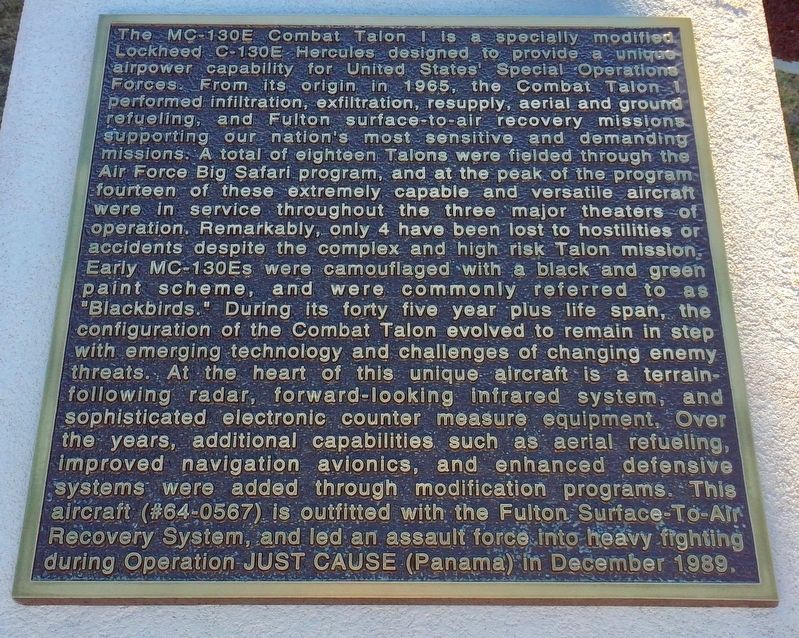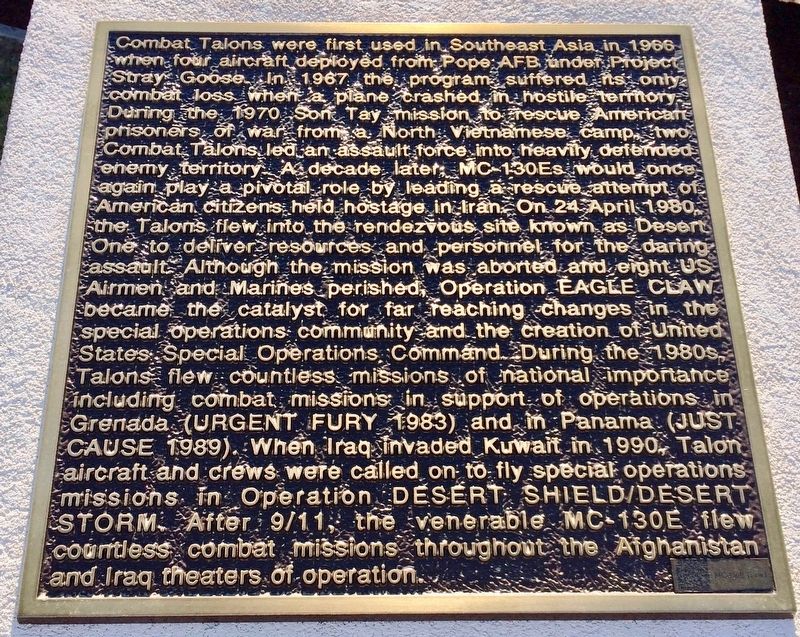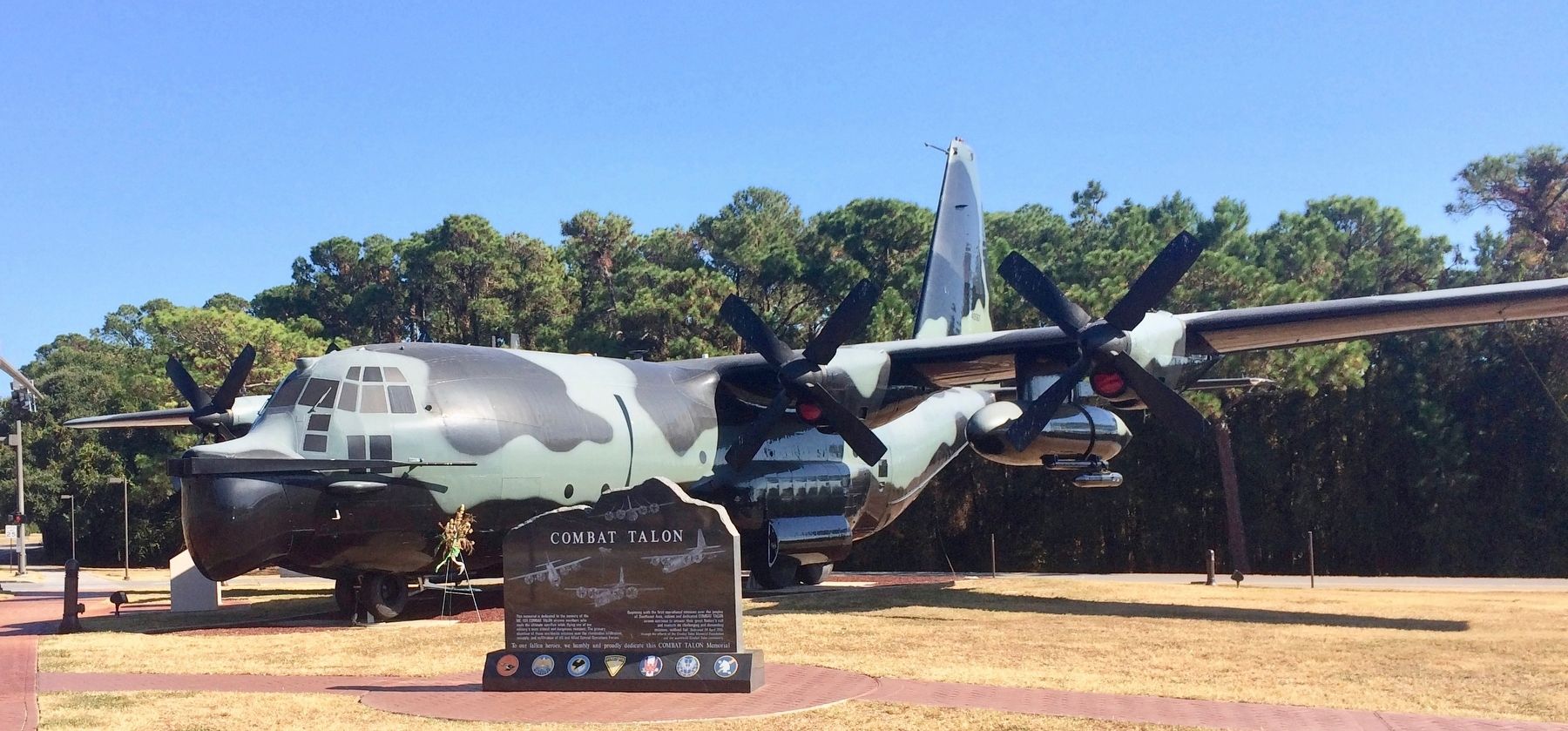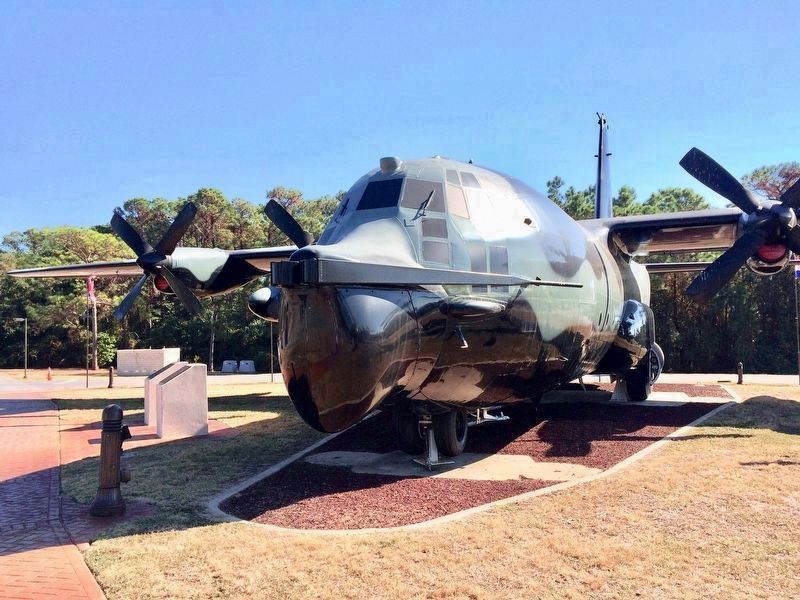Hurlburt Field in Okaloosa County, Florida — The American South (South Atlantic)
MC-130E Combat Talon I
Left side plaque
The MC-130E Combat Talon I is a specially modified Lockheed C-130E Hercules designed provide a unique airpower capability for United States Special Operations Forces. From its origin in 1965, the Combat Talon performed infiltration, exfiltration, resupply, aerial and ground refueling, and Fulton surface-to-air recovery missions supporting our nation's most sensitive and demanding missions: A total of eighteen Talons were fielded through the Air Force Big Safari program, and at the peak of the program fourteen of these extremely capable and versatile aircraft were in service throughout the three major theaters of operation. Remarkably, only 4 have been lost to hostilities or accidents despite the complex and high risk Talon mission. Early MC-130Es were camouflaged with a black and green paint scheme, and were commonly referred to as “Blackbirds.” During its forty five year plus life span, the configuration of the Combat Talon evolved to remain in step with emerging technology and challenges of changing enemy threats. At the heart of this unique aircraft is a terrain following radar, forward-looking infrared system, and sophisticated electronic counter measure equipment. Over the years, additional capabilities such as aerial refueling, improved navigation avionics, and enhanced defensive systems were added through modification programs. This aircraft (#64-0567) is outfitted with the Fulton Surface-To Air Recovery System, and led an assault force into heavy fighting during Operation JUST CAUSE (Panama) in December 1989.
Right side plaque
Combat Talons were first used in Southeast Asia in 1966 when four aircraft deployed from Pope AFB under Project Stray Goose. In 1967 the program suffered its only combat loss when a plane crashed in hostile territory. During the 1970 Son Tay mission to rescue American prisoners of war from a North Vietnamese camp, two Combat Talons led an assault force into heavily defended enemy territory. A decade later MC-130Es would once again play a pivotal role by leading a rescue attempt of American citizens held hostage in Iran. On 24 April 1980 the Talons flew into the rendezvous site known as Desert One to deliver resources and personnel for the daring assault. Although the mission was aborted and eight US Airmen, and Marines perished, Operation EAGLE CLAW became the catalyst for far reaching changes in the special operations community and the creation of United States Special Operations Command. During the 1980s, Talons flew countless missions of national importance including combat missions in support of operations in Grenada (URGENT FURY 1983) and in Panama (JUST CAUSE 1989). When Iraq invaded Kuwait in 1990, Talon aircraft and crews were called on to fly special operations missions in Operation DESERT SHIELD/DESERT STORM. After 9/11, the venerable MC-130E flew countless combat missions throughout the Afghanistan and Iraq theaters of operation.
Erected by the Hurlburt Field Memorial Air Park Council.
Topics. This historical marker is listed in these topic lists: Air & Space • Military. A significant historical date for this entry is April 24, 1980.
Location. 30° 24.897′ N, 86° 41.991′ W. Marker is in Hurlburt Field, Florida, in Okaloosa County. Marker can be reached from Independence Road near Oneal Avenue. Located at the Hurlburt Field Memorial Air Park and access to the base is restricted. Touch for map. Marker is at or near this postal address: 315 Independence Road, Hurlburt Field FL 32544, United States of America. Touch for directions.
Other nearby markers. At least 8 other markers are within walking distance of this marker. Combat Talon / Here Am I; Send Me. Isaiah 6:8 (a few steps from this marker); AC-130 Spectre (within shouting distance of this marker); A-37 "Dragonfly" (within shouting distance of this marker); In Honor of The American Gold Star Mothers (within shouting distance of this marker); First Lieutenant James Phillip Fleming (within shouting distance of this marker); AT-28D Trojan (within shouting distance of this marker); Air America Memorial (within shouting distance of this marker); Hmong Special Guerrilla Units (within shouting distance of this marker). Touch for a list and map of all markers in Hurlburt Field.
Regarding MC-130E Combat Talon I.
MC-130E tail #64-0567 history:
This aircraft, tail #64-0567 was the first fixed-wing aircraft to land using Night Vision Goggles on 26 Nov. 1979. The aircraft also flew during Operation URGENT FURY in Grenada. Later, this aircraft was the first Combat Talon to undergo the first
phase of the extensive MOD-90 conversion project which consisted of critical upgrades to the aircrafts radar systems navigational suite. During Operation JUST CAUSE, #64-0567 was the lead aircraft of a five-ship formation that served as the conflicts first assault on 19 Dec. 1989 at Rio Hato, AB, Panama and later exfiltrated Manuel Noriega from Panama on 2 Jan. 1990.
The Fulton surface-to-air recovery system (STARS) was used to extract personnel and materials via air. A large helium balloon raised a nylon lift line into the air, which was snagged by a large scissors-shaped yoke attached to the nose of the plane. The yoke snagged the line and released the balloon, yanking the attached cargo off the ground with a shock less than that of an opening parachute. A sky anchor secured the line and wires stretched from the nose to both leading wing tip edges protected the propellers from the line on missed snag attempts. Crew members hooked the snagged line as it trailed behind and attached it to the hydraulic winch, pulling the attached person or cargo into the plane through the rear cargo door.
Also see . . . Wikipedia article on the MC-130E Combat Talon I. (Submitted on November 22, 2016, by Mark Hilton of Montgomery, Alabama.)
Credits. This page was last revised on November 23, 2016. It was originally submitted on November 22, 2016, by Mark Hilton of Montgomery, Alabama. This page has been viewed 823 times since then and 34 times this year. Photos: 1, 2, 3, 4. submitted on November 22, 2016, by Mark Hilton of Montgomery, Alabama.



